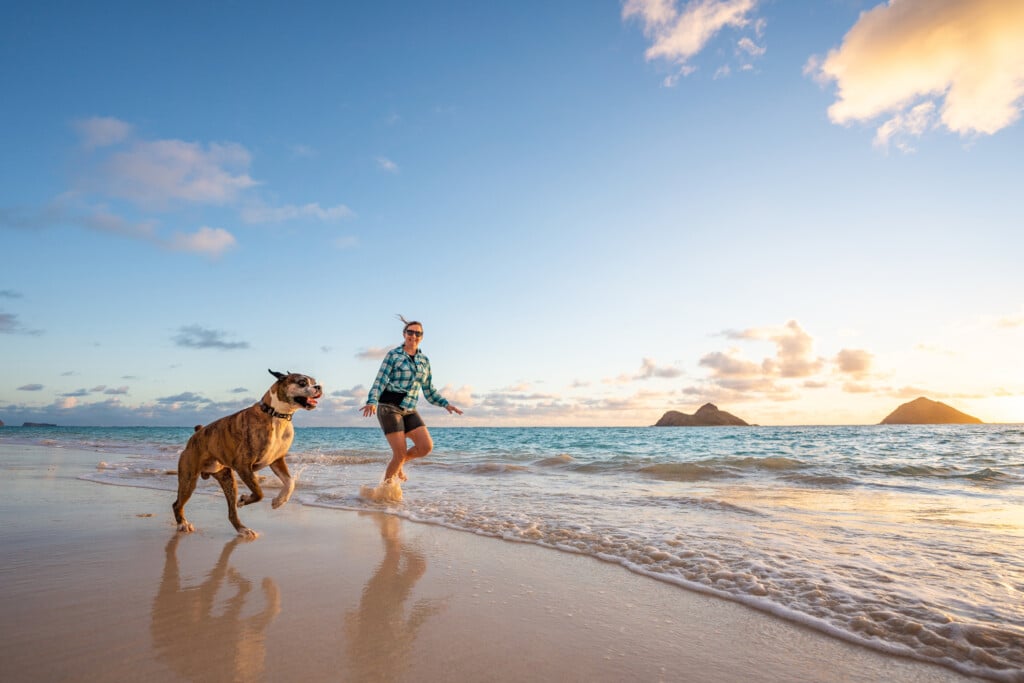How to Travel with your Dog to Hawaiʻi
It's not easy being a pet parent, but it is possible take your fur children with you on vacation to Hawaiʻi—here's how.

Traveling with a pet can be a lot of work. From finding the right carrier to making sure your furry little friend is relaxed, it can be a lot of stress bringing your dog with you on vacation. Fortunately, it’s not impossible—however if you’re planning to travel to Hawaiʻi with your dog, you’ve got to be extra-prepared. Here are a few key points you should know about on how to travel with your dog to Hawaiʻi.
1. Microchipping
Before you do anything on this checklist, make sure that your dog is microchipped. Any pet that can not be identified using its microchip—so make sure that number is working—will be subject to quarantine and will not be able to participate in any of Hawaiʻi’s early release programs.
2. Rabies and Hawaiʻi
Currently, Hawaiʻi is the only state in the US that is free of rabies. Because of this, animals coming in to the state are put under strict—and lengthy—quarantines at state facilities. However, if you follow the correct procedures and get your dog vaccinated for rabies, you can skip the 120 day holding of your pet—which for obvious reasons, would ruin your vacation.
To skip the rabies quarantine and to have your dog released to you at the airport upon arrival, you’ll need to check off a number of objectives. First and foremost, your pet will need to have been vaccinated for rabies at least two times in its life. Said rabies vaccinations will need to have been administered at least 30 days apart from one another—and the most current rabies vaccination must have been done more than 30 days prior to your pets arrival in Hawaiʻi. It’s also important to note that you’ll need to keep both rabies vaccination certifications from your vet.
3. FAVN Rabies Antibody Test
To prove that your animal is rabies-free, you’ll also need a passing FAVN rabies antibody test result from an approved lab—which includes but are not limited to facilities at Auburn University, Kansas State University, University of Missouri or the DOD Food Analysis and Diagnostic Laboratory in Texas. The timing of these tests are important, as your approved lab will need to have received your pets blood samples less than 36 months and more than 30 days before your dogs arrival in Hawaiʻi. Once again, you’ll want to keep a copy of your pet’s successful blood test for your records—and be sure to obtain such documentation from your vet and not the lab that performed the test.
But wait, there’s more. Pets that have passed the FAVN Rabies Antibody Test will still need to wait 30 days—from the day the lab received your animal’s blood test—before arriving in Hawaiʻi. Pets that arrive on Oʻahu before this 30 day period will be immediately disqualified from the early release program and will have to be quarantined at the owner’s expense.
4. Paperwork, Paperwork, Paperwork
You will need a lot of documentation to get your dog approved for the state’s early release program. Fortunately, you can find a checklist of all documentation necessary here. (It’s Checklist 1, unless you’re planning to travel to a neighbor island like Kauaʻi, Maui or Hawaiʻi Island.) All in all, you’ll need:
- A completed Dog & Cat Import Form AQS-279
- Two original certificates for rabies vaccinations, signed in ink by your vet
- An original (not photocopied) health certificate for your pet, done within 14 days of their arrival to Hawaiʻi
- Proof of tick and tapeworm treatment by your vet
5. How to Submit your Documents
If you’ve crossed all your t’s and dotted your i’s, it’s time to get your paperwork in the mail. You’ll want to send all of your documents together and so they are received more than 10 days prior to your arrival. Documents can be sent to Animal Quarantine Station, 99-951 Halawa Valley Street, Aiea, Hawaii, 96701 with a return receipt to verify delivery, or by an overnight carrier that provides tracking of your documents.
You’ll also want to include a cashier’s check for $185 (for direct release) or $244 (for the 5 Day or Less program) with your documents, payable to the Department of Agriculture. You’ll also want to keep copies of all documentation mailed with you as your travel with your pet, in case it is needed during arrival.
6. Day of Arrival
Be sure to schedule your flights around the hours of the Airport Animal Quarantine Holding Facility (AAQHF) at the Daniel K. Inouye International Airport (HNL). Operating from 8 a.m. to 4:30 p.m., animals delivered to the AAQHF after it has closed will not be released until the following day, from 8 to 10 a.m.—and animals that are not picked up during this period will be transferred to the Animal Quarantine Station in Halawa.
It can take pets up to an hour to be delivered to the airport’s holding facility, so be sure to schedule your flights with arrival times that will allow you and your dog plenty of time to make it through the AAQHF or you may have to wait an additional day to be reunited with your pet. (The AAQHF also closes an hour early, at 3:30 p.m., on weekends and state holidays.)
7. Neighbor Island Travel
If your final destination isn’t Oʻahu, but is a neighbor island like Kauaʻi, Maui or the Big Island, you’ll need to complete Checklist 2 and not Checklist 1 on the aforementioned website. While many of the steps are the same, you’ll need to also complete a Neighbor Island Inspection Permit, which comes with its own rules and regulations.
8. Pet Friendly Accommodations
Fortunately, once you’re out of the airport and finally enjoying the warmth of Hawaiʻi’s sun, you can easily find pet-friendly digs around the state. From the Turtle Bay Resort on Oʻahu’s North Shore—which your dog will love exploring—to the glamorous Four Seasons Resort Lānaʻi on Lānaʻi, there are plenty of places around Hawaiʻi for you and your fur child to stay.


